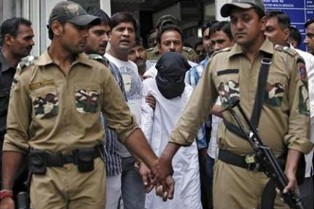
Mumbai, July 21: Arrested 26/11 key handler Abu Jundal was brought to Mumbai in the wee hours today after a Delhi court handed over his custody to Mumbai ATS, which wanted him in connection with a series of terror attacks in Maharashtra.
"Jundal was flown to Mumbai and taken to a safe place amid tight security," a police official told PTI.
Jundal will be later today produced before the Chief Metropolitan Magistrate in Esplanade Court in south Mumbai, which has been heavily guarded by the police.
Delhi's Chief Metropolitan Magistrate Vinod Yadav yesterday directed that Jundal be handed over to Mumbai ATS after the Delhi Police said he was no longer required to be interrogated by it in the Jama Masjid attack case.
Jundal is wanted by the Mumbai Police in the 2006 Aurangabad arms haul case, the 26/11 Mumbai mayhem, the 2010 German Bakery blast and attack on Nashik Academy, a state-level training institution for Maharashtra Police personnel.
"This accused is required in Mumbai in four cases. This court deems it fit at this stage to transfer the custody of the accused to ATS Mumbai only for the purpose of production of this accused before Chief Metropolitan Magistrate, Mumbai on July 21 before 4 PM," the court ordered yesterday.
"The CMM, Mumbai would in his wisdom consider the comparative merit and the requirement of the accused in the four cases and would grant custody of this accused accordingly," the court had said.
The court also directed that "after completion of the interrogation of the accused in these four cases, he be brought back to Delhi, so that the issue of handing over of his custody to NIA and other agencies may be considered."
Mumbai ATS had told the court that Jundal's custody is "absolutely essential" in the Aurangabad arms haul case, where he is an accused and has been declared a proclaimed offender.
Officers from the Detection Crime Branch and Mumbai ATS also stressed for Jundal's custody in the German bakery blast case and the Nashik Police Academy case, saying he was one of the conspirators in those incidents.





Comments
Add new comment